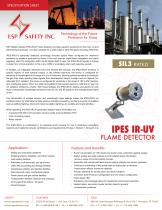
Catalog excerpts

SPECIFICATION SHEET Technology of the Future Protection for Today ESP Safety’s Model IPES-IR/UV Flame Detector provides superior sensitivity for fires from oil and petrochemical products. It is also indicated for a wide range of other fire types including metal fires. IPES-IR/UV’s advanced detection technology includes optical filters configured for maximum sensitivity to radiation produced by flame or fire and ensures rapid flame recognition and alarm signaling. Upon fire recognition within its 90-degree field of view, the IPES-IR/UV signals a change in state from normal operation to fire in any OEM or proprietary alarm and response system. In addition, via integrated ultraviolet (UV) and infrared (IR) sensors, the IPES-IR/UV monitors in specific regions of both spectral ranges. In the infrared spectrum, the device is configured for sensitivity to wavelengths in the range of 4.2 to 4.6 microns, allowing optimal sensitivity to combustible gas fires while rejecting false signals from incandescent lamps, sunlight and hot objects. For ultraviolet (UV) radiation, the device is configured for sensitivity in the range of 180 to 250 nanometers, making the sensor “blind” to sunlight and radiation from heated objects but still able to “see” the UV radiation emitted by a flame. With these settings, the IPES-IR/UV detects and alarms for only those characteristic wavelength emissions from the UV and IR spectrum that indicate actual flame or fire. The combination of multiple sensors and wavelength range settings makes the IPES-IR/UV an excellent choice for elimination of false positive indicators caused by non-flame sources of radiation such as artificial lighting, direct and indirect sunlight, lightning, arc welding and metal grinding. While operating, the IPES-IR/UV generates detector-status information via: • A standard RS-485 communication channel under protocol Modbus RTU • 4-20 mA analog output • Relay outputs The IPES-IR/UV is constructed in an explosion-proof housing for use in hazardous (classified) locations and meets the industry certifications and requirements of Class I, Division 1, Group B, C & IPES IR-UV FLAME DETECTOR Applications • Drilling and production platforms • Power consumption of <3W means low power costs, protection against surges • Digital, analog and relay outputs provide reliable status information across a range of communication formats • Automatic and manual self-tests ensure system integrity and correct operation • Continuous monitoring of the optical path for obstruction or reduced transmission affords maximum reliability • Industry standard for remote alarm and fault indication • Combines both IR sensor configuration and UV sensor configuration • Color status LED • Explosion-proof package allows for hazardous environment operation • Heated optics, secondary heater function helps to prevent condensation problems • Shipping tankers, freighters, and other vessels • Fuel loading facilities • Refineries, bulk terminals, and tank farms • LNG/LPG processing and storage facilities • Compressor stations and pipeline facilities • Petrochemical, paint, and fertilizer plants • Power plants and gas turbine facilities • Transportation facilities (airports and subways) • Oil and gas fired boilers / furnaces • Aircraft hangars 555 N. First Street | San Jose, CA 95112 Ph: +1-408-886-9746 | Fx: +1-408-886-9757
Open the catalog to page 1
info@espsafetyinc.com Response: Very High Sensitivity Field of View The detector has a 90° field of view (horizontal) with the highest sensitivity lying along the central axis. Viewing Angle Electrical Characteristics Voltage Typical Response Time (Sec.) < 2.0 W, standby < 3.0 W, during alarm < 5.0 W, self test < 7.3 W, maximum with heated window & alarm 1) Analog signal 4 - 20 mA 2 mA ± 0.1 mA Fault signal Ready signal 4 mA ± 0.1 mA Fire signal 18 mA ± 0.1 mA 8 mA ± 0.1 mA Test Mode 2) RS 485, Modbus RTU - normally open relay - closed on fire detection - latching / non-latching Fault: -...
Open the catalog to page 2





